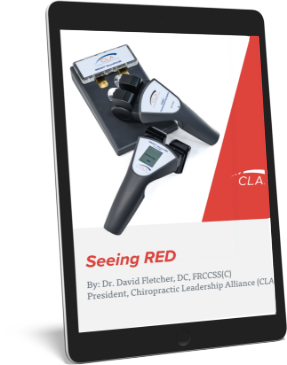Recently, a Calgary radiologist began a movement to restrict the availability of x-ray services for chiropractors. The absurdity of this position is apparent to any thoughtful clinician, medical or chiropractic. As a direct contact health care provider, the doctor of chiropractic is responsible for determining the safety and appropriateness of chiropractic care. (1) This responsibility includes the detection and characterization of vertebral subluxations.
Plain films and radiation safety
Plain film radiography has been the mainstay of imaging in most chiropractic practices. (2) Growing concern for the hazards of ionizing radiation and the availability of alternative imaging techniques may cause this to change. According to a National Research Council report, low doses of x-radiation pose a human cancer risk three to four times higher than previously reported. The report also noted that some fetuses exposed to radiation face a higher than expected risk of mental retardation. (3)
This does not mean that the chiropractor should abandon plain film radiography and dispatch all patients for an MRI study. It does mean developing increased awareness of the judicious use of ionizing radiation, and implementing radiographic procedures which minimize risk and maximize the amount of information obtained from the study.
Radiation protection is particularly important when x-raying infants, children, adolescents, and adults in their reproductive years. It has been stated that “For examination of the skeleton, there is no modality to match the time and cost effectiveness of the plain film radiograph.” (2)
The Bureau of Radiological Health emphasizes the importance of clinical judgement in selecting radiographic procedures. The Bureau also recognizes the right of the attending doctor to make benefits vs. risks determinations in selecting radiographic procedures. A Bureau publication states, in part:
In almost every medical situation, when the physician feels there is reasonable expectation of obtaining useful information from roentgenological examination that would affect the care of the individual, potential radiation hazard is not a primary consideration…The physician should retain complete freedom ofjudgement in the selection of roentgenologic procedures, and (the physician) should conform with good technical practices. (4)
The following are indications for pediatric radiologic examination:
1. History of trauma with clinical signs suggestive of fracture or dislocation.
2. Clinical suspicion of infection or neoplasm.
3. Clinical evidence of a congenital or developmental anomaly (e.g. Down’s syndrome) which could alter the nature of the chiropractic care rendered, or which may itself require treatment.
4. When clinical findings are equivocal, and the suspected condition can be detected or ruled out by plain film radiography.
5. When other examination procedures fail to disclose the nature of the condition, and the patient is not responding favorably to care.
6. To characterize the biomechanical component of the vertebral subluxation complex when such characterization would likely alter the chiropractic care (i.e. the direction and locations of adjustive intervention) and less hazardous or more accurate alternative examinations are not available.
7. To evaluate patient response to chiropractic care when such evaluation may alter the nature of the care being rendered, and less hazardous or more accurate alternative examinations are not available. (5)
Vertebral subluxation
Vertebral subluxations have been implicated as significant etiologic factors in a variety of conditions. (6,7,8,9,10) Subluxation can also be associated with congenital or developmental variation. (11) Many vertebral subluxations are asymptomatic, or produce symptoms quite distant from the anatomical site of involvement. (12) However, spinal subluxations may also associated with local tenderness. (13) Thus, it is important for the chiropractor to recognize the far reaching consequences of vertebral subluxation in the developing spine. The use of plain film spinography to characterize subluxations is indicated if the information to be gained cannot be obtained through clinical examination (14).
References
1. Gelardi T, Miller J, Drake M, Barge F, Healey J: “Questions and answers regarding SCASA memo.” Dynamic Chiropractic 8(5):37,1990.
2. Yochum T, Rowe L: “Essentials of Skeletal Radiology.” Williams & Wilkins. Baltimore, MD, 1987.
3. Ellett W: “Biological Effects of Ionizing Radiation (BEIR V).” National Research Council. Washington, DC, 1990.
4. “X-Ray Examinations — A Guide to Good Practice.” U.S. Department of Health, Education, and Welfare, Public Health Service. Washington, DC, 1971.
5. Kent C, Plaugher G, Borges D, et al: Chapter 8. “Diagnostic Imaging.” In: Anrig C, Plaugher G: “Pediatric Chiropractic.” Williams & Wilkins. Baltimore, MD. 1998.
6. Gutmann G: “Blocked atlantal nerve syndrome in infants and small children.” International Review of Chiropractic 46(4):37, 1990. (Reprinted from Manuelle Medizin Springer-Verlag, 1987).
7. Fysh P: “Upper respiratory infections in children: a chiropractic approach to management.” International Review of Chiropractic 46(3):29.
8. Klougart N, Nilsson N, Jacobsen J: “Infantile colic treated by chiropractors: a prospective study of 316 cases.” JMPT 12:281,1989.
9. Hart D, Libich E, Fischer S: “Chiropractic adjustments of the cervicothoracic spine for the treatment of bronchitis with complications of atelectasis.” International Review of Chiropractic 47(2):31.
10. Barge FH: “Wryneck.” Printed by Palmer Publications, Inc. Amherst, WI. 1998.
11. McMullen M: “Handicapped infants and chiropractic care: Down syndrome — Part I.” International Review of Chiropractic 46(4):32,1990.
12. Janse J, Houser R, Wells B: “Chiropractic Principles and Technic,” Chicago, IL. National College of Chiropractic, 1947. P. 235.
13. Ibid P. 312
14. Kent C: “An overview of pediatric radiology in the chiropractic practice.” International Review of Chiropractic 46(4):45, 1990.




























































